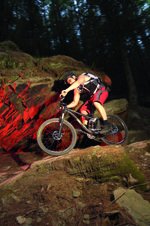 SUSPENSION
SUSPENSION
The DW-link is a twin-link suspension configuration with constant chain growth, a high level of initial anti-squat and a relatively low leverage ratio. As with the longer travel DW-link bikes the MkIII is linear mid-stroke and tends to bottom easily. So getting the spring rate correct is more critical than some other designs and we have the marks on the 170mm cranks to prove it. As for whether or not anti-squat works, well the Fox Float R shock has no ProPedal lever or lockout and the MkIII is one of the best-climbing bikes on test.
Steering is precise with the Pike fork and the 20mm bolt-through lowers are noticeably stiffer under braking. The Maxle is easy to use and is definitely the best 20mm QR system on the market.
COMPONENTS
Ditching the WTB WeirWolf tyres on last year’s bike for Maxxis High Rollers has transformed the handling of the MkIII. It no longer squirms exiting a corner and the bike is altogether more predictable regardless of the riding conditions. The DT wheels are super-solid and reliable but they are more suited to a lightweight freeride bike than the MkIII, unless of course you’re a heavy rider who is hard on kit.
PERFORMANCE
From a suspension point of view the MkIII is possibly the best middle-ring climbing bike on test, both in terms of traction and anti-squat, as it remains active without bobbing. There is no pedal feedback in the 32t chainring but drop it into the granny and it begins to rear its ugly head.
Point the MkIII downhill and the geometry is at odds with the solid build kit. It’s as if the front wheel is tucked too far under the front end, making it easier to pitch the rider’s weight forward on steeper trails. We tried to combat this by running less sag on the fork to prop the front end up and found that firmer fork dramatically improved the handling of the bike. It’s not that the head angle on the MKIII is ultra-steep; it’s just that the front end of the bike is just a tad short.
VERDICT
While a lighter finishing kit would be more in-keeping with the geometry and weight of the MkIII frame, what we really craved was more stability at speed. Obviously you can’t change the head angle of the bike but you can move the front wheel further in front of the rider and increase the wheelbase by simply going up a frame size. The 19in frame has the same standover height as the 17in, it will climb just as well but it will feel more stable descending due to the extra length up front. With a lighter spec on a larger frame size, the Iron Horse MkIII could easily up its rating to a 9.
MBR RATING: 8/10



